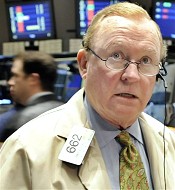VOA标准英语10月-World Markets Rebound from Monday's Plunge(在线收听)
 |
| Trader James O'Callahan watches the numbers at a post on the New York Stock Exchange floor, 07 Oct 2008 |
One day after sinking to its lowest level in four years, Wall Street's Dow Jones Industrial Average opened higher. Major European markets recorded gains in late-day trading.
The only major exchange to record a significant downturn was in Tokyo, where the Nikkei finished with a 3 percent loss.
After near-panic selling Monday amid continued worries about a growing credit crunch that could stunt global economic growth, markets appear calmer, according to Eugene Peroni of the U.S. financial firm Advisors Asset Management.
"The worst fears about all of this may have largely played out yesterday. I do think that Wall Street will begin to sense that the bailout plan will have some effect, that it will start to calm nerves," Peroni said.
Last week, President Bush signed into law a massive financial rescue package that empowers the federal government to buy bad debt from struggling U.S. financial institutions.
In addition, the Federal Reserve says it will take steps to make it easier for American companies to finance short-term needs like payroll obligations and purchasing supplies. Another option open to central banks hoping to facilitate borrowing would be an interest-rate cut.
Australia's central bank has lowered a key interest rate by a full percentage point. The European Central Bank left interest rates unchanged last week, but left open the possibility of a future rate cut.
Gold continues to rise. Crude oil is trading higher after several weeks of steep declines.